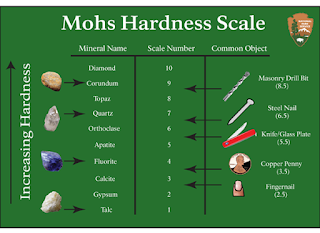The Elcometer 501 Pencil Hardness Tester has been designed to ensure that the cylindrical pencil lead is maintained at a constant angle of 45° and exerts a force of 7.5N (1.68lbF).
Paint thickness
Paint thickness
Although, paint thinness would be a more apt description.
The first layer applied to the metal panel of a vehicle is the primer. Primer is designed to make the panel uniform so as to allow the paint colour to be evenly applied to it. Primer thickness, whilst varying according to car marque and individual plant operating processes, is usually between 8 microns (µm) and 38 microns (µm).
The second layer is the base colour, a semi-gloss layer that actually gives the panel its final colour. If the colour requires a flake or pearlescent to it, this is usually mixed in at this level. The thickness of this layer ranges from 13 microns (µm) to 38 microns (µm).
The final layer is the clear coat, an optically clear layer of lacquer designed to protect the base colour from UV degradation and oxidation. The thickness of this layer ranges from 38 microns (µm) to 102 microns (µm).
Paint thickness
So the total thickness of the various layers on most modern cars is between 67 microns (µm) and 198 microns (µm).
Surface Hardness
Is defined as the ability of a material to resist local deformation (or penetration) from externally applied pressure, and is directly related to its tensile strength; stronger materials are generally harder. The enamel paint finishes on vehicles from the 50’s and 60’s era were as tough as porcelain.
But rightly due to environmental concerns, those high percentage petroleum based paints have been generally superseded, resulting in the softer water-based paint finishes of today and the unavoidable orange-peel seen on many new and re-painted vehicles.
But rightly due to environmental concerns, those high percentage petroleum based paints have been generally superseded, resulting in the softer water-based paint finishes of today and the unavoidable orange-peel seen on many new and re-painted vehicles.
Today’s paints, unfortunately, rank somewhere near the bottom of the scale of hardness, especially single coat black/red paint the exception being white single stage and CeramiClear, when compared to all the materials your paint can possibly come in contact with
Mohs scale of mineral hardness
An adaptation of that hardness scale (1 - 10)
• Talc = 1H
• Carbon Black [black paint pigmentation] = 2H
• Glass = 6H
• Titanium dioxide [white paint pigmentation] = 7H
• Corundum 9H
• Diamond =10 H
Pencil Hardness
A test uses special pencils with different degrees of hardness to scratch the coating, which then determines its hardness - http://www.woodweb.com/knowledge_base/Testing_Your_Coatings_Hardness.html
Most coatings are formulated for specific types of finishes, various conditions or different substrates. So use the pencil hardness test as one criterion for selection. But do not judge any coating by pencil hardness alone, as there are many other significant characteristics to consider.
Pencil Hardness for Common Coatings
Catalyzed polyester: 9H
Catalyzed polyurethane: 9H
Catalyzed modified acrylic polyurethane: 4H
Catalyzed acrylic polyurethane: 2H
Water based polyurethane: 3H
Water-based urethane/isocyanate catalyst: 2H
Urethane/nitrocellulose lacquer: F (24 hours)
Water reducible lacquer: 2H
Water-based polyurethane wipe-on finish: HB-F
Clear shellac aerosol: 3B
Polyurethane/nitrocellulose aerosol: HB
Nitrocellulose aerosol: 3B
Paint hardness
Hard and soft are both relative terms; you can scratch the hard surface of a vehicle paint with a soft towel by the application of enough pressure. Both pressure and mechanical stress are defined as force per unit area. These two forces are the subject of Newton's third law of motion; the law of reciprocal actions [: to every action, there is an equal and opposite reaction]
Paint hardness, more accurately, density, can be affected by a number of factors including the composition of the paint used (i.e. single, dual component or powder) and how it is applied. There is a trade off to be had at the manufacturing stage between scratch resistance and gloss levels against oven drying time and temperature, along with the quality of the isocyanates (products that add gloss and accelerate paint hardening times).
Low (soft) paint density can also occur if the base colour coat is not allowed sufficient hardening time before the clear coat is applied. In order to better understand the relevance of density/hardness, it is necessary to compare them, a hardness scale is required. So, given the definition of ‘hardness’ is a material’s relative resistance to deformation, scratching or penetration, we can measure it on the Mohs scale.
How can a hard clear coat be so easily scratched?
Force acts through a body that has a surface area; if the surface area is really small while maintaining an equal force, the pressure becomes astronomical and the object under pressure capable of penetrating the surface of an otherwise tough material. That’s why a micro fine thread that is twice as fine as silk and 100 times finer than a human hair, in an otherwise soft towel will scratch your paint. And the same reason a mosquito can penetrate a rhino hide with its proboscis (stinger)
Copyright © 2002-2017, TOGWT ™ Ltd (Established 1980) all rights reserved


No comments:
Post a Comment